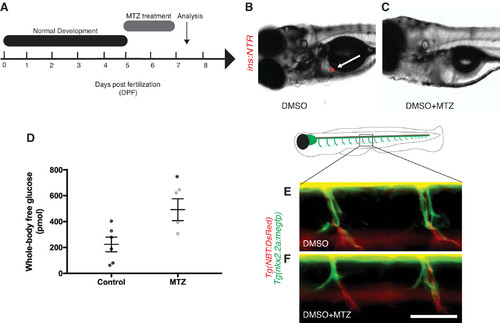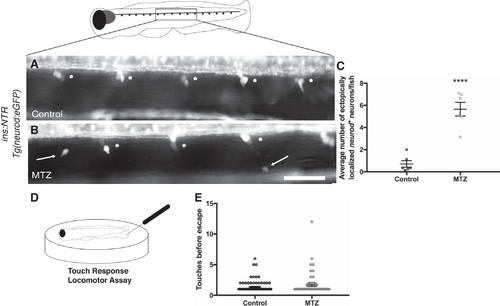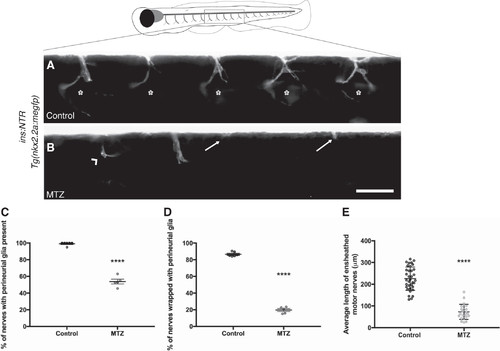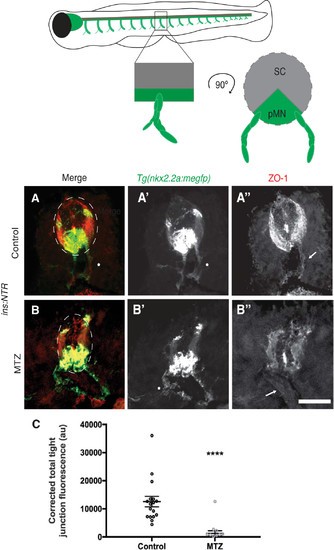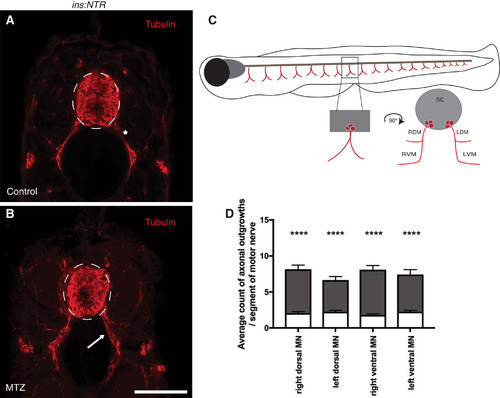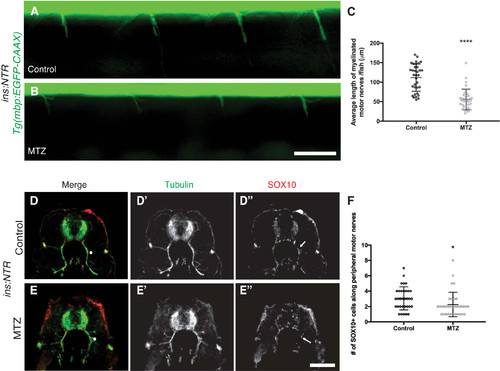- Title
-
Acute effects of hyperglycemia on the peripheral nervous system in zebrafish ( Danio Rerio) following nitroreductase-mediated β-cell ablation
- Authors
- Rocker, A., Howell, J., Voithofer, G., Clark, J.K.
- Source
- Full text @ Am. J. Physiol. Regul. Integr. Comp. Physiol.
|
Nitroreductase (NTR)-mediated β-cell ablation induces acute hyperglycemia. A: schematic outline of treatment schedule. MTZ, metronidazole. B and C: treatment of 5-days postfertilization (dpf) ins:NTR fish for 2 days with 10 mM MTZ leads to selective ablation of pancreatic β-cells (C), which are unaffected by DMSO alone (B, red, arrow). D: following the schedule of treatment described in A, there was a significant difference in blood glucose levels in MTZ-treated compared with control fish. *P = 0.0239. E and F: lateral view of non-ins:NTR, Tg(nkx2.2a:megfp); Tg(NBT;DsRed) fish treated with DMSO or DMSO + 10 mM MTZ to determine possible off-target effects of MTZ. NTR, nitroreductase; NBT, neural-specific β-tubulin; megfp, monomeric enhanced green fluorescent protein; DsRed, Discosomared. No differences were observed. Scale bar = 50 μm. |
|
Acute hyperglycemia affects ensheathment by the perineurium. A: in control ins:NTR;Tg(nkx2.2a:megfp) fish 7 days postfertilization (dpf), the perineurium is present in regular intervals (asterisks) along the spinal cord. NTR, nitroreductase; megfp, monomeric enhanced green fluorescent protein. B: following the schedule of treatment described in Fig. 1A, nkx2.2a+ perineurial glia in ins:NTR;Tg(nkx2.2a:megfp) fish are stalled at the motor exit point along the spinal cord (white arrows) and are occasionally observed in ectopic locations (arrowhead). MTZ, metronidazole. Scale bar = 50 μm. C: percentage of nerves in which perineurial glia were present was higher in control than MTZ-treated fish. ****P < 0.0001. D: fewer nerves were properly ensheathed by the perineurium in MTZ-treated than control fish. ****P < 0.0001. E: perineurial segments along the peripheral nerve were shorter in MTZ-treated than control fish. ****P < 0.0001. |
|
Acute hyperglycemia affects ensheathment by the perineurium. A: in control ins:NTR;Tg(nkx2.2a:megfp) fish 7 days postfertilization (dpf), the perineurium is present in regular intervals (asterisks) along the spinal cord. NTR, nitroreductase; megfp, monomeric enhanced green fluorescent protein. B: following the schedule of treatment described in Fig. 1A, nkx2.2a+ perineurial glia in ins:NTR;Tg(nkx2.2a:megfp) fish are stalled at the motor exit point along the spinal cord (white arrows) and are occasionally observed in ectopic locations (arrowhead). MTZ, metronidazole. Scale bar = 50 μm. C: percentage of nerves in which perineurial glia were present was higher in control than MTZ-treated fish. ****P < 0.0001. D: fewer nerves were properly ensheathed by the perineurium in MTZ-treated than control fish. ****P < 0.0001. E: perineurial segments along the peripheral nerve were shorter in MTZ-treated than control fish. ****P < 0.0001. |
|
Acute hyperglycemia affects the integrity of the perineurium. A: in control ins:NTR;Tg(nkx2.2a:megfp) fish 7 days postfertilization (dpf), zonula occludens (ZO)-1+ tight junctions are apparent along the motor nerve (A′′, arrow), indicated by their alignment with the perineurium (A′, asterisk). NTR, nitroreductase; megfp, monomeric enhanced green fluorescent protein. B: treatment of 5-dpf ins:NTR;Tg(nkx2.2a:megfp) fish for 2 days in 10 mM metronidazole (MTZ) leads to noticeably absent or attenuated ZO-1+ tight junctions (B′′, arrow), even when the perineurium is present (B′, asterisk). Note immaturity of the nkx2.2a+ perineurial cells (B′, asterisk). SC, spinal cord; pMN, motor neural progenitor domain. Scale bar = 50 μm. C: intensity of ZO-1 fluorescence was significantly lower in MTZ-treated than control fish. au, Arbitrary units. ****P < 0.0001. |
|
Peripheral motor axons appear defasciculated in hyperglycemic larvae. A and B: following the schedule of treatment described in Fig. 1A, axons (red, acetylated α-tubulin) appear defasciculated in the ins:NTR metronidazole (MTZ)-treated group (B, arrow) compared with the ins:NTR control group (A, asterisk). Dashed lines outline the spinal cord. NTR, nitroreductase. Scale bar = 50 μm. C: schematic of the areas in which axonal outgrowths were quantified: left dorsal muscle (LDM), right dorsal muscle (RDM), left ventral muscle (LVM), right ventral muscle (RVM), and spinal cord (sc). D: no differences were observed between segments within the groups. Number of axonal outgrowths was significantly greater in MTZ-treated (gray bars) than control (white bars) segments. MN, motor nerve. ****P < 0.0001. |
|
Acute hyperglycemia affects myelination and Schwann cell count along the motor nerve. A and B: lateral view of the spinal cord of control and metronidazole (MTZ)-treated ins:NTR;Tg(mbp:EGFP-CAAX) fish following the schedule of treatment described in Fig. 1A. NTR, nitroreductase; mbp, myelin basic protein; EGFP, enhanced green fluorescent protein. C: length of myelinated nerves was significantly shorter in MTZ-treated than control ins:NTR;Tg(mbp:EGFP-CAAX) fish. ****P < 0.0001. D and E: cross sections through ins:NTR zebrafish labeled with an antibody against Sox10 (red) and acetylated α-tubulin (green) in control and MTZ-treated fish. F: treatment of 5-days postfertilization (dpf) ins:NTR fish for 2 days with 10 mM MTZ leads a modest decrease in Sox10+ cells (D′′ and E′′, arrows) along the motor axons (D′ and E′) in MTZ-treated compared with control fish. *P < 0.05. Scale bars = 50 μm. |

